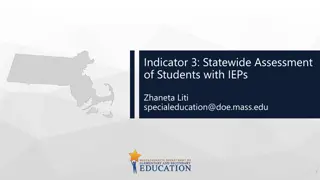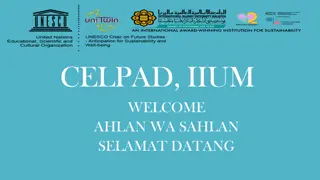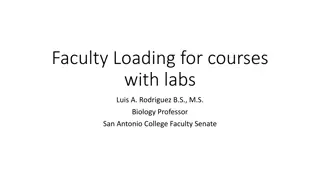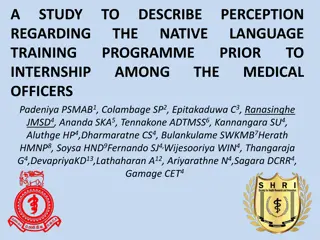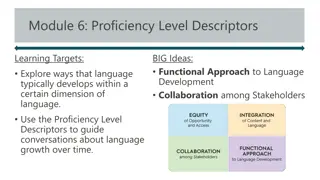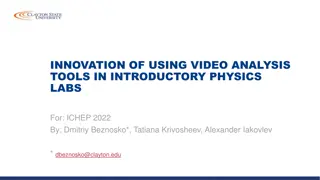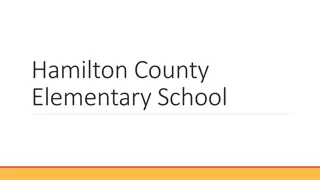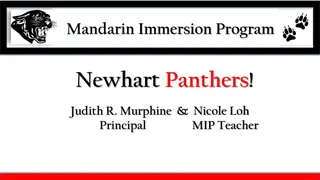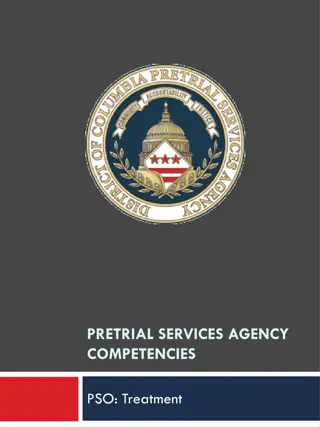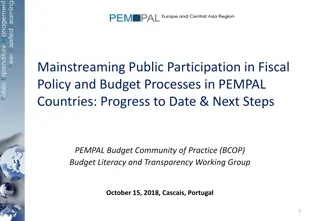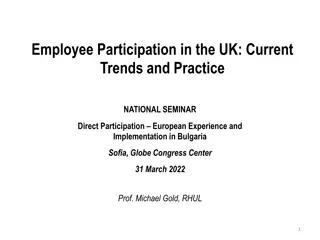Proficiency Test 2021 Summary: Labs Participation and Trends
Fifty-one labs participated in the ESWG Proficiency Test 2021, with 37 completing the paper challenge and 47 completing the wet exercise. The questionnaire revealed sequencing and software trends, highlighting equipment ownership and future acquisitions. An in-depth analysis of markers used and concordance in results was provided, showcasing the overall success of the exercise. Certificates will be issued to participants.
Uploaded on Sep 19, 2024 | 0 Views
Download Presentation

Please find below an Image/Link to download the presentation.
The content on the website is provided AS IS for your information and personal use only. It may not be sold, licensed, or shared on other websites without obtaining consent from the author. Download presentation by click this link. If you encounter any issues during the download, it is possible that the publisher has removed the file from their server.
E N D
Presentation Transcript
ESWG - Proficiency test 2021 Daniel Kling Head Organizer daniel.kling@rmv.se
Summary 51 labs participated 37 completed paper challenge 47 completed wet exercise Participants 60 50 Number of labs 40 Total 30 Wet 20 Paper 10 0 2015 2016 2017 2018 2019 2020
Questionnaire Sequencing trends 18 labs (35%) own sequencing instrument. 2 planning to buy Sequencing trends 25% 20% Percentage of labs 15% Illumina Ion torrent 10% Sanger 5% 0% 2015 2016 2017 2018 2019 2020
Questionnaire Software trends Use of software 40 35 30 Number of labs Familias 25 DNA view 20 LIMS Excel 15 FamLink 10 Genoproof 5 0 2015 2016 2017 2018 2019 2020
Questionnaire Linked markers Not accounted for: 10 Not used: 15 Exclude one: 15 Accounts for: 11
Wet exercise - Summary Overall very concordant results (despite the use of potentially different databases) 49 labs participated (47 submitted results) Consult the Excel summary for details For the wet exercise some labs results have been highlighted (red or orange) which indicates a result that deviates. Certificates will still be issued.
Wet exercise A single alleged father A single lab reported SNP markers Marker D22S1045 displayed greatest variation (6-40)
Wet exercise per marker LR variation Outliers
Paper challenge - Background A mysterious case Four children Generate pedigrees
Paper challenge Part a) List all possible combinations with the following conditions 1. Four children (none of them can be parents) 2. Any number of parents 3. No inbreeding etc 4. Essentially all sibling combinations Essentially a combinatorial problem 1. Software to generate pedigrees (only non-redundant) 2. We can work out the number mathematically
Paper challenge Part a) Familias will give you 225 unique pedigrees (maternal/paternal half sibs are considered separately). 6561 if redundancy is not considered. 9 labs reported 225, other numbers are all different Stirling and Bell numbers will give you the same Let s give it a try!
Paper challenge Part a) Stirling number of the second kind S(n,k) will give you how many ways to combine n objects into k sets. We can use tables or formulas, see https://en.wikipedia.org/wiki/Stirling_numbers_of_the_second_kind k is the number of sets (fathers/mothers) n is the number of children
Paper challenge Part a) n means the number of children, i.e. 4 k means the number of paternal or maternal relations. So k=1 means all children are unrelated (a single father) and k=4 means they are all paternally/maternally related k is the number of sets (fathers/mothers) n is the number of children
Paper challenge Part a) S(4,1)=1, There is 1 way to partition 4 children among 1 father. This is the pedigree where one father has four children. S(4,2)=7, There are 7 ways to partition 4 children among 2 fathers. These are the pedigrees where 1 father has 3 children and the other father has 1 child or each father has 2 children. See below. S(4,3)=6, There are 6 ways to partition 4 children among 3 fathers. These are the pedigrees where 1 father has 2 children and two fathers each have one child. See below. S(4,4)=1, There is 1 way to partition 4 children among 4 fathers. These are the pedigrees where each of the four fathers has one child. k is the number of sets (fathers/mothers) n is the number of children
Paper challenge Part a) Next, Bell numbers (Bn) are the sum for a particular n of all Stirling numbers. So B4=1+7+6+1=15 in the table below k is the number of sets (relations) n is the number of children
Paper challenge Part a) To get the total number of pedigrees we multiply the maternal and paternal number of pedigrees, 15x15=225 Fewer if we do not consider maternal and paternal half siblings separately. Tricky, but may be useful! We will next consider subsets of these pedigrees!
Paper challenge Part b) 9 labs would do the pairwise approach 11 labs would use the stepwise approach 16 labs would do the joint Bayesian
Paper challenge Part b) Example: Consider three potential full siblings (S1,S2 and S3), inclusion threshold=100 (or 99%) LR(S1 and S2)=10 LR(S1 and S3)=100 LR(S2 and S3)=10 LR(S1, S2 and S3)=20000 Pairwise approach would conclude that S1 and S3 are full siblings, S2 is inconclusive. Joint Bayesian approach would conclude that all are full siblings, since LR(S1,S2 and S3)/LR(S1 and S3)=20000/100=200 or more correctly we would use posteriors. Pr(S1,S2 and S3)=20000/(20000+10+10+100)=99.4%
Paper challenge Part c) Expected LR=4E+27 -> Extremely strong evidence in favor of full siblings A possible mutation at SE33, consistent with a one step event
Paper challenge Part d) Can be worked out in Familias, 30 unique pedigrees 11 labs reported 30 pedigrees Can be worked out using Stirling and Bell numbers! Recall, there are still 15 combinations where they can be paternally related, but now only 2 ways they can be maternally related. So in total 15x2=30 pedigrees
Paper challenge Part e) Top 3 results amounts to 0.999 (99.9%) of the posterior probabilty 24 labs reported full siblings as the most likely LR=3.72E+17, posterior=0.86 LR=2.99E+16, posterior=0.069 Identical LRs LR=2.99E+16 , posterior=0.069
Paper challenge Part e) If we decide that half siblings should not be distuinguised (maternal from paternal) LR=3.72E+17, posterior=0.92 LR=2.99E+16, posterior=0.074
Paper challenge Summary Complex case Generate pedigrees Evaluate different approach to multiple pedigree testing Posterior versus LR Mutation(!) Video will be available through https://familias.name/ESWG/
Proficiency test Future Not determined who will organize next ESWG board will decide
ESWG - Proficiency test 2021 Daniel Kling Head Organizer daniel.kling@rmv.se








